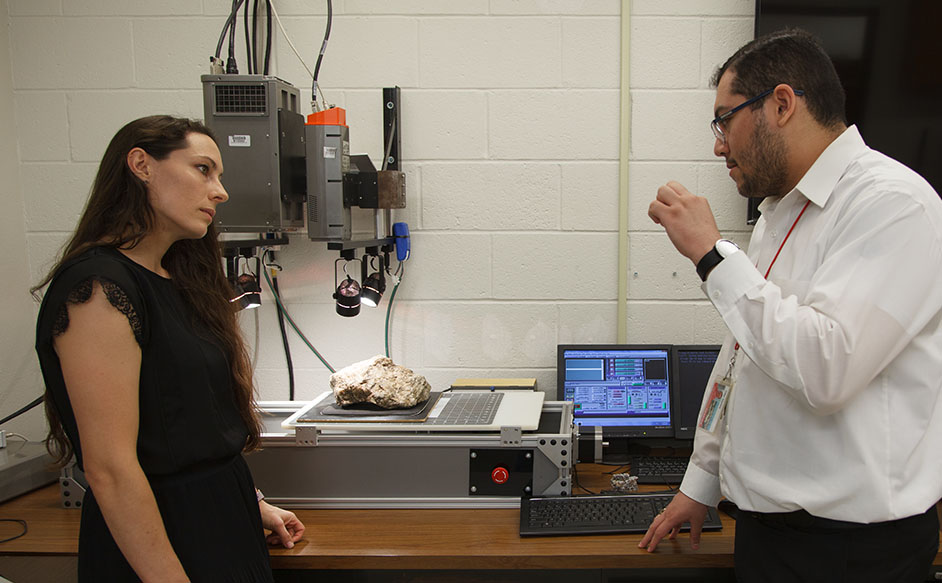Greater Demand Due to Clean Energy Transition Presents New Challenges
In today’s increasingly digital and interconnected world, the demand for critical minerals, also known as rare earth elements (REE) has surged. These essential elements are the lifeblood of modern technology, powering smartphones, electric vehicles and renewable energy infrastructure.

The search for critical minerals is presenting new challenges as they have become more difficult to find. This is especially true in the United States, where many companies ceased mining for REEs and resorted to help from countries, like China, where REEs are more abundant.
Researchers at the University of Houston have focused their efforts on finding more efficient ways to discover critical minerals.
Otto Gadea, a geology Ph.D. student, and Shuhab Khan, professor of geology at the UH College of Natural Sciences and Mathematics, have discovered a new method to detect critical minerals and their concentrations across rock surfaces.
“Some of these minerals are really critical from a strategic standpoint for this country,” said Khan. “Their absence would have a negative effect on business and the economy.”
The method Khan and Gadea propose is based on mathematics and uses a new bastn̈asite index in conjunction with hyperspectral imaging of rock samples.
With their new method, the relative amount of bastn̈asite and how it varies spatially across rock surfaces can be determined quickly and efficiently through a simple mathematical expression calculated from reflectance data in hyperspectral images from rocks. Their results were published in IEEE Geoscience and Remote Sensing Letters.
Using Math and Imaging to Detect Critical Minerals
Bastn̈asite is a fluorocarbonate mineral that is rich in REEs, particularly cerium, lanthanum, neodymium and europium. These elements are essential for various electronics, magnets and components to power electric vehicles.
While labeled as rare, these REEs are relatively abundant in the Earth’s crust. The reason they appear scarce is because of how they are dispersed throughout the crust and mixed with other deposits.
Geological formations that bear bastn̈asite are known to exist in various isolated localities across the U.S. However, according to Khan and Gadea, it is currently difficult to identify and locate highly concentrated veins of this valuable mineral.
“Even with the help of experienced geologists that have been trained for decades to find REE-rich minerals, it is still a challenge for crews to obtain detailed information about the spatial distribution of these minerals throughout a prospective site,” said Gadea. “Our method addresses this issue by providing these crews with an efficient alternative tool with the potential to achieve a similar or superior performance in mapping these critical minerals.”
Khan and Gadea tested the method on rock samples taken from Mountain Pass, California, where mining has reignited at the once-bustling Sulfide Queen mine.
The mine contains a 1.4-billion-year-old Precambrian carbonatite, the largest in the U.S., that can contain ores with up to 12% REE oxides in weight. Crews are exploring the mine for waste left after years of previous mining activity with hopes of salvaging the remains.
Hyperspectral imaging is a cutting-edge technology that combines principles of conventional imaging with spectroscopy. It captures a wide range of wavelengths, typically spanning from ultraviolet to infrared, allowing for identification of minerals based on their unique spectral signatures. By analyzing the reflected or emitted light from a target area, hyperspectral imaging can distinguish between different minerals with great accuracy.
When it comes to REEs, hyperspectral imaging holds great potential for their detection because it can identify a mineral of interest as well as detect minerals that signal valuable ore deposits in the same area.
Using their method, Khan and Gadea found patches with various concentrations of bastn̈asite in their samples.
Potential to Detect Critical Minerals from Space
“Even though our process was applied to hand samples we examined, it’s adaptable to entire regions through the use of drones, airplanes and satellites,” said Khan.
Traditional methods of detecting REEs have proven to be time consuming and costly for companies, often requiring extensive drilling and laboratory analysis.
“With this technique, they would be able to detect REE-rich areas before anyone starts to dig,” said Gadea. “This will save a lot of time and resources.”
Gadea added that it will also enable the detection of REEs in areas that have little to no accessibility by humans.
Major Investment to Find Critical Minerals
“This technique and others that will follow will absolutely help the U.S. reach the production status of REEs that it had in the past,” said Gadea.
The U.S. is investing billions to find sources of critical minerals so that it can become less dependent on others as it works to transition to clean energy.
“One of the biggest developments in the last decade has been sensor technology,” said Khan. “Sensing critical minerals from a distance will be a key to our success in the energy transition.”
- Chris Guillory, College of Natural Sciences and Mathematics